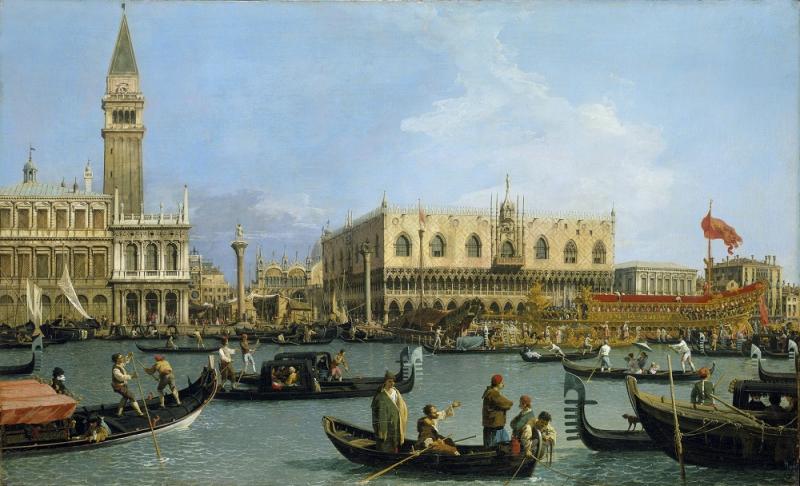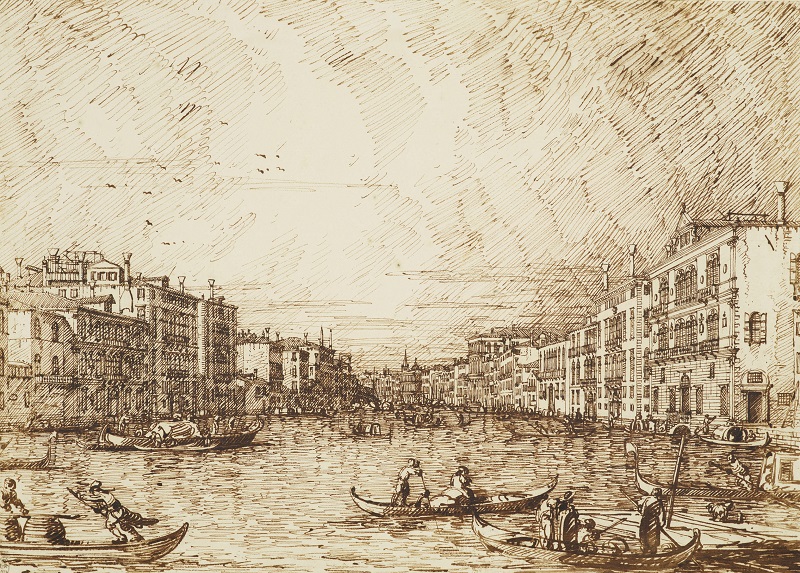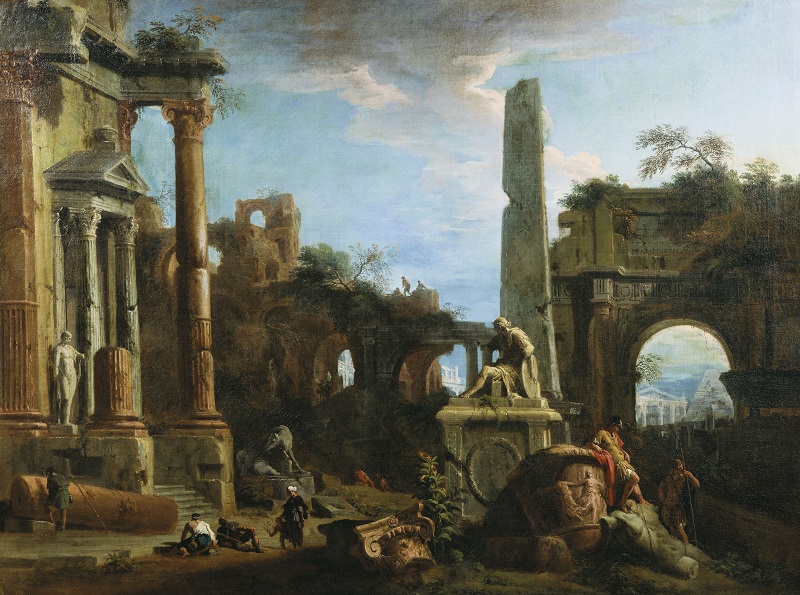Canaletto & the Art of Venice, The Queen's Gallery - preview | reviews, news & interviews
Canaletto & the Art of Venice, The Queen's Gallery - preview
Canaletto & the Art of Venice, The Queen's Gallery - preview
One of the world's great collections reveals the secrets of an 18th-century master

Even today, the perception of Venice as a city only half-rooted in mundane reality owes a great deal to Canaletto (1697-1768), an artist who made his name producing paintings for English tourists visiting Italy in the 18th century. Recognisable views are subtly altered, the gently improving instincts of the artist shifting the scene almost imperceptibly away from real life, and into the realms of the imagination.
In the days of the Grand Tour, the effect must have been even more pronounced, and Lucy Whitaker, co-curator of a new exhibition at the Queen’s Gallery, compares the paintings to picture postcards, explaining that visitors arriving in Venice “looked at the city and judged it against the Canalettos they had already seen in their own country”.
Having marvelled at the volcanoes of Naples and the classical remains of Rome, a stay in Venice promised Grand Tourists a period of untrammelled enjoyment. Full of music and theatre, prostitutes and gambling, Venice was famed for its regattas and feast days, public spectacles that celebrated the city’s glorious past in a strange and otherworldly way. Chief amongst these was the Marriage of the Sea, an ancient ceremony that tourists rushed across Italy to see, captured in all its pomp in Canaletto’s painting The Bacino di San Marco on Ascension Day, c. 1733-4 (main picture).
Souvenirs of these events were extremely popular with foreign visitors, with many British tourists paying a visit to Joseph Smith, British Consul in Venice, and a collector and dealer of books and art. Whitaker explains that he was vital not only to Canaletto’s success, but also to the quality of the Royal Collection’s holdings today. “While he was doing his work as Consul he was also collecting; he was a dealer as well and he became Canaletto’s unofficial partner and was a great negotiator for him, selling his works on or arranging their sale to Grand Tourists, most of whom were British.” Smith collected not just Canaletto, but all the major artists working in Venice in the early 18th century, as well as Old Masters. “When he was in his late seventies his business wasn’t going so well and he was looking to sell," says Whitaker, "The young George III had come to the throne in 1760 and was really interested in Smith’s collection of books, but the sale was negotiated so that the whole lot was brought into the Royal Collection.”
Smith collected not just Canaletto, but all the major artists working in Venice in the early 18th century, as well as Old Masters. “When he was in his late seventies his business wasn’t going so well and he was looking to sell," says Whitaker, "The young George III had come to the throne in 1760 and was really interested in Smith’s collection of books, but the sale was negotiated so that the whole lot was brought into the Royal Collection.”
Consequently, the Royal Collection has the finest and most extensive holdings of Canaletto anywhere, the exhibition serving as an impressive monument to a single collector. Displayed in their original, albeit slightly altered frames, the paintings are hung densely in the 18th-century manner, affording, hopes Whitaker, “a sense of walking into Consul Smith’s palazzo on the Grand Canal”.
The size and quality of the collection also allows an appreciation of Canaletto’s technique and development as an artist. Long thought to have worked outside using a camera obscura to record architectural and topographical details, infra-red examination of highly finished drawings, like The Central Stretch of the Grand Canal, c.1734 (pictured above), indicates a different working method altogether. It is now believed that he made preliminary studies outside, from which carefully constructed drawings were produced in the studio, drawings that might appear to be true to reality, but are often highly contrived and composed of more than one viewpoint. The exhibition shows the extraordinary talent of Canaletto, says Whitaker, but is also the first to show his work alongside that of contemporaries like Sebastiano and Marco Ricci and Francesco Zuccarelli. While Canaletto specialised in cityscapes, Sebastiano Ricci was producing altarpieces and history paintings, his nephew Marco Ricci painting landscapes based on the Venetian countryside and developing the capriccio, a popular genre that featured real or fantasy architecture in an idealised setting (pictured above: Capriccio View with Roman Ruins, c.1729). Inspired by Ricci, Canaletto also produced capricci at different points in his career, with further parallels between the two artists suggested in their very particular use of light. While Canaletto is by far the best-known of the group, taken altogether, they not only showcase a special and historic collection, but offer a tantalising glimpse of the cultural and artistic life of Venice at one of its most exciting moments.
The exhibition shows the extraordinary talent of Canaletto, says Whitaker, but is also the first to show his work alongside that of contemporaries like Sebastiano and Marco Ricci and Francesco Zuccarelli. While Canaletto specialised in cityscapes, Sebastiano Ricci was producing altarpieces and history paintings, his nephew Marco Ricci painting landscapes based on the Venetian countryside and developing the capriccio, a popular genre that featured real or fantasy architecture in an idealised setting (pictured above: Capriccio View with Roman Ruins, c.1729). Inspired by Ricci, Canaletto also produced capricci at different points in his career, with further parallels between the two artists suggested in their very particular use of light. While Canaletto is by far the best-known of the group, taken altogether, they not only showcase a special and historic collection, but offer a tantalising glimpse of the cultural and artistic life of Venice at one of its most exciting moments.
- Canaletto & the Art of Venice at the Queen's Gallery, Buckingham Palace from Friday 19 May until 12 November
- Read more visual arts coverage on theartsdesk
Share this article
The future of Arts Journalism
You can stop theartsdesk.com closing!
We urgently need financing to survive. Our fundraising drive has thus far raised £49,000 but we need to reach £100,000 or we will be forced to close. Please contribute here: https://gofund.me/c3f6033d
And if you can forward this information to anyone who might assist, we’d be grateful.

Subscribe to theartsdesk.com
Thank you for continuing to read our work on theartsdesk.com. For unlimited access to every article in its entirety, including our archive of more than 15,000 pieces, we're asking for £5 per month or £40 per year. We feel it's a very good deal, and hope you do too.
To take a subscription now simply click here.
And if you're looking for that extra gift for a friend or family member, why not treat them to a theartsdesk.com gift subscription?
more Visual arts
 'We are bowled over!' Thank you for your messages of love and support
Much-appreciated words of commendation from readers and the cultural community
'We are bowled over!' Thank you for your messages of love and support
Much-appreciated words of commendation from readers and the cultural community
 Lee Miller, Tate Britain review - an extraordinary career that remains an enigma
Fashion photographer, artist or war reporter; will the real Lee Miller please step forward?
Lee Miller, Tate Britain review - an extraordinary career that remains an enigma
Fashion photographer, artist or war reporter; will the real Lee Miller please step forward?
 Kerry James Marshall: The Histories, Royal Academy review - a triumphant celebration of blackness
Room after room of glorious paintings
Kerry James Marshall: The Histories, Royal Academy review - a triumphant celebration of blackness
Room after room of glorious paintings
 Folkestone Triennial 2025 - landscape, seascape, art lovers' escape
Locally rooted festival brings home many but not all global concerns
Folkestone Triennial 2025 - landscape, seascape, art lovers' escape
Locally rooted festival brings home many but not all global concerns
 Sir Brian Clarke (1953-2025) - a personal tribute
Remembering an artist with a gift for the transcendent
Sir Brian Clarke (1953-2025) - a personal tribute
Remembering an artist with a gift for the transcendent
 Emily Kam Kngwarray, Tate Modern review - glimpses of another world
Pictures that are an affirmation of belonging
Emily Kam Kngwarray, Tate Modern review - glimpses of another world
Pictures that are an affirmation of belonging
 Kiefer / Van Gogh, Royal Academy review - a pairing of opposites
Small scale intensity meets large scale melodrama
Kiefer / Van Gogh, Royal Academy review - a pairing of opposites
Small scale intensity meets large scale melodrama
 Jenny Saville: The Anatomy of Painting, National Portrait Gallery review - a protégé losing her way
A brilliant painter in search of a worthwhile subject
Jenny Saville: The Anatomy of Painting, National Portrait Gallery review - a protégé losing her way
A brilliant painter in search of a worthwhile subject
 Abstract Erotic, Courtauld Gallery review - sculpture that is sensuous, funny and subversive
Testing the boundaries of good taste, and winning
Abstract Erotic, Courtauld Gallery review - sculpture that is sensuous, funny and subversive
Testing the boundaries of good taste, and winning
 Edward Burra, Tate Britain review - watercolour made mainstream
Social satire with a nasty bite
Edward Burra, Tate Britain review - watercolour made mainstream
Social satire with a nasty bite
 Ithell Colquhoun, Tate Britain review - revelations of a weird and wonderful world
Emanations from the unconscious
Ithell Colquhoun, Tate Britain review - revelations of a weird and wonderful world
Emanations from the unconscious
 Rachel Jones: Gated Canyons, Dulwich Picture Gallery review - teeth with a real bite
Mouths have never looked so good
Rachel Jones: Gated Canyons, Dulwich Picture Gallery review - teeth with a real bite
Mouths have never looked so good

Add comment